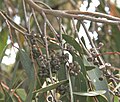Eucalyptus dives: Difference between revisions
CSV import |
CSV import |
||
| Line 28: | Line 28: | ||
{{tree-stub}} | {{tree-stub}} | ||
{{food-stub}} | {{food-stub}} | ||
<gallery> | |||
File:Eucalyptus_dives_leaf1.JPG|Eucalyptus dives leaf | |||
File:Eucalyptus_dives_flowers.jpg|Eucalyptus dives flowers | |||
File:Eucalyptus_dives_fruit.jpg|Eucalyptus dives fruit | |||
</gallery> | |||
Latest revision as of 01:59, 18 February 2025
Eucalyptus dives, also known as the Broad-leaved Peppermint, is a species of Eucalyptus native to southeastern Australia. It is a common tree in the Australian Alps and other high altitude areas in southeastern Australia.
Description[edit]
The Eucalyptus dives is a medium to tall tree, typically growing to a height of 20–30 m, but can reach up to 50 m in favourable conditions. The bark is rough, fibrous and grey-brown in colour, shedding in small flakes. The leaves are broad, lance-shaped and peppermint-scented, hence the common name. The flowers are white and bloom in summer.
Distribution and habitat[edit]
Eucalyptus dives is found in southeastern Australia, from the Blue Mountains in New South Wales, through the Australian Alps and into eastern Victoria. It grows in a variety of habitats, from dry sclerophyll forest to wet sclerophyll forest and woodland. It is often found on poor, shallow soils.
Uses[edit]
The leaves of the Eucalyptus dives are rich in essential oils and are used in the production of Eucalyptus oil. The oil has a strong, fresh, peppermint-like scent and is used in aromatherapy, as a decongestant, and in the manufacture of cleaning products. The timber is hard and durable, making it suitable for construction and furniture making.
Conservation[edit]
The Eucalyptus dives is not currently considered to be at risk of extinction. However, like all native Australian flora, it is protected under the National Parks and Wildlife Act 1974.
See also[edit]
References[edit]
<references />
-
Eucalyptus dives leaf
-
Eucalyptus dives flowers
-
Eucalyptus dives fruit





